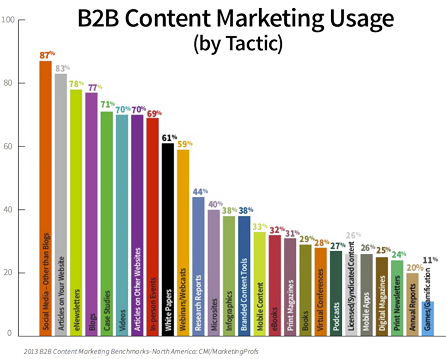As the Web becomes more sophisticated and Google changes search algorithms to favor websites that offer quality content, the SEO paradigm is shifting. Slowly but surely, almost everything that used to constitute search engine optimization (SEO) has become ineffective, risky, or inappropriate for most brands.
Instead, the focus of SEO is on improving the user experience by creating high quality relevant content, a user-friendly interface, and an integrated search and social media effort.

A study on B2B Content Marketing Trends for 2013 by the Content Marketing Institute, identifies these content marketing trends:
- 91% of B2B companies use content marketing
- Social media is the most popular content marketing tactic
- LinkedIn is the most popular social media channel for content distribution (83%) followed by Twitter (80%), Facebook (80%) and You Tube (61%)
- The biggest jump in content marketing tactics is the use of research reports, followed by videos, mobile content, and virtual conferences
Developing a content marketing strategy
Your content marketing strategy should build your brand and add value to your products and/or services. The basic strategy involves developing quality content, optimizing it for search engines, and distributing it in as many vehicles as you can. The goal is to create multiple links to your site from all across the Internet to boost your website’s search results.
In short, content marketing can be broken down into three steps:
- Content Development — The biggest challenge for most companies is content creation. If you don’t have a skilled writer on your team to create compelling content to engage your customers and prospects, try to find a freelance writer that understands your industry.
- Content Optimization — For your content marketing campaign to work, you’ll have to make sure to include the right keywords and optimize it for search engines. It might make sense to work with an SEO specialist to accomplish this. There are also tools available to help optimize your content.
- Content Distribution — To get the most from your content marketing program, multiple distribution channels should be used for each content piece. Posting content in multiple channels on a regular basis is time consuming. There are many tools available to help you distribute your content in multiple channels at once to save time and make it easier.
Distributing your content
To choose vehicles for distributing content, think about your industry and what might work best to engage your customers and prospects. Here are some options to get your juices flowing:
- Press releases
- Videos
- Articles
- Case Studies
- White Papers
- Email Newsletters
- Blogs
- RSS
- Social Media/Web 2.0 sites
- Web Pages
- Guest Posts
- Syndication
- Conference Presentations
- Research Reports